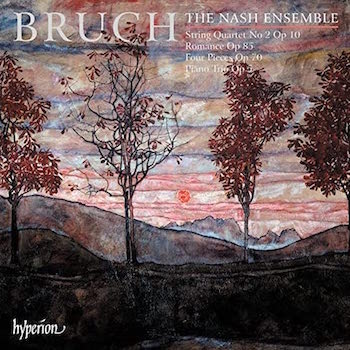Classical Album Review: The Nash Ensemble — Bruch’s Chamber Music
By Jonathan Blumhofer
One could hardly ask for more persuasive Bruch advocacy than what the Nash Ensemble offers here.
 If one can think of Antonin Dvorak as “Brahms with a smile,” perhaps Max Bruch is “Brahms with a frown”?
If one can think of Antonin Dvorak as “Brahms with a smile,” perhaps Max Bruch is “Brahms with a frown”?
No…that’s not quite right. Sure, Bruch’s approach to form and phrasing could sometimes be strict. But he was an accomplished tunesmith whose most popular works – the G-minor Violin Concerto and Scottish Fantasy – are deservedly admired. And he wrote much more that should be better regarded than it is. That Bruch’s wider output was overshadowed by contemporaries like Wagner, Brahms, Mahler, and Stravinsky wasn’t entirely his fault; his fundamentally conservative aesthetic belied a sharper-than-average musical mind.
A good bit of the latter comes out in the Nash Ensemble’s latest compendium of Bruch’s chamber music. Their program spans much of the composer’s career, from the 1857 Piano Trio in C minor to the 1911 Romance for viola and piano (Bruch lived a long life: he died, two months shy of eighty-three, in 1920). In between come the String Quartet no. 2 (from 1860) and Four Pieces (from 1896).
The early Trio is an attractive piece, its three movements full of mature, Bruch-ian hallmarks: rich-toned, passionate melodic writing; graceful, dancing lines (the second movement features a stout, but lilting, Trio); and moments of thrilling virtuosity.
True, it’s the stormy finale that makes the Trio and the Nash players – violinist Stephanie Gonley, cellist Adrian Brendel, and pianist Simon Crawford-Phillips – deliver a furious, spirited account of that movement. But their larger interpretation, with its strong contrasts of mood, clean-textures, rhythmic precision, and glowing tone, is utterly winning.
Likewise ingratiating is the resonant, characterful reading of the Four Pieces that Brendel and Crawford-Phillips turn in. Everything about this performance is natural and directed, from the soaring cello playing in the opening “Aria” to the wise excision of repeats in the “Swedish” dance and the nicely weighted keyboard accompaniments in the “Scottish” finale.
The excellent violist Lawrence Power joins Crawford-Phillips for a songful rendition of the Romance; while Power, Gonley, Brendel, and violinist Jonathan Stone team up for Bruch’s E-major Second String Quartet.
This is, again, a lovely piece, one that really ought to be in the repertoire. Yes, it echoes some Mendelssohn, Schumann, and Brahms.
But the end of the first-movement exposition and the start of its development are marked by ear-catching harmonic and dramatic turns. The second movement’s references to Beethoven’s op. 130 “Cavatina” – a hesitant violin melody; hearty, noble central section – assume their own, distinctive shape. The Scherzo is a boisterous romp, the finale shapely and flowing.
It’s all music the Nash players have easily in hand, technically and expressively.
Their playing in the outer movements is urgent and persuasive. The Scherzo overflows with personality: indeed, it’s cut from the same cloth as the Piano Trio’s finale. Throughout, the ensemble’s reading is beautifully balanced, rhythmically taut, and dynamically bracing. To be sure, one could hardly ask for more persuasive Bruch advocacy than what the Nash Ensemble offers here – both in the Quartet and on the larger album.
Jonathan Blumhofer is a composer and violist who has been active in the greater Boston area since 2004. His music has received numerous awards and been performed by various ensembles, including the American Composers Orchestra, Kiev Philharmonic, Camerata Chicago, Xanthos Ensemble, and Juventas New Music Group. Since receiving his doctorate from Boston University in 2010, Jon has taught at Clark University, Worcester Polytechnic Institute, and online for the University of Phoenix, in addition to writing music criticism for the Worcester Telegram & Gazette.
